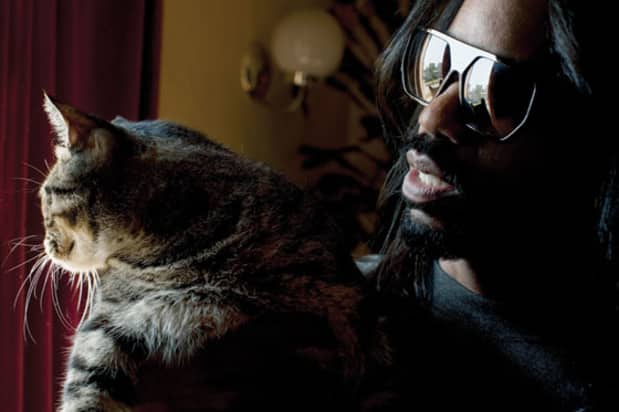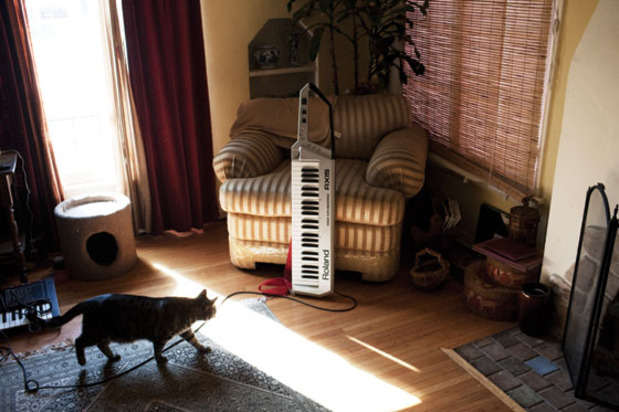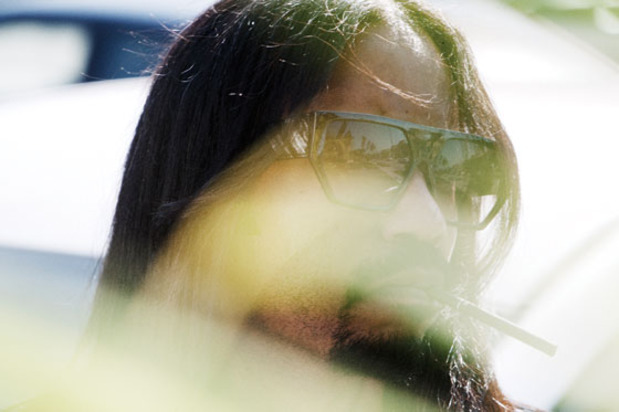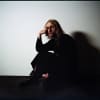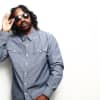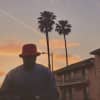Riding north up Arlington Avenue toward a downtown rehearsal studio, Dam-Funk points out a dark, thin stream of smoke billowing high above the San Gabriel Mountains—a sign of what will, a week later, be declared one of the largest wildfires in Southern California history. The last time his Leimert Park neighborhood endured any type of cataclysmic fire damage was during the Rodney King riots of 1992—the point when a decade of gentrification boiled over and South Central burned. Almost two decades later, “South Central” has officially been renamed “South Los Angeles,” and this particular area is rich with afrocentric boutiques and soul food restaurants, home to popular jazz den The World Stage and birthplace of Project Blowed’s influential hip-hop open mic night. Dam-Funk’s street is the picture of suburbia, rows of single-family homes with Spanish tile roofs and children bouncing unsupervised across well-manicured lawns. And yet for the past four years, Dam (pronounced “dame”) has lived quietly among them, burying his unique prowess deep within the community that inspired it.
It’s an eerily comfortable 90-plus degrees as we drive, but Dam expresses concern for the crates housing his life’s treasure and their ability to withstand the inevitable warping this kind of heat brings. Back in Leimert Park, packed into a one-car garage behind his house, is a colossal record collection spanning decades of his objectively soulful musical interests, dense with early ’80s funk and boogie. Also in the garage are turntables, recording equipment and vintage synthesizers, yet something is definitely missing. Three weeks ago, Dam tracked down and bought a vintage keytar, which he’s since mastered. Most recently cast as visual gag in Snoop Dogg’s retro-tourist “Sensual Seduction” video, the keytar is Dam’s latest joy. Later in the evening, during the rehearsal for Master Blazter, the band he’s recruited to blow out his entirely self-produced compositions, he fingers the instrument as he sings through a vocoder, effectively altering time and space. Behind pitch black sunglasses, under one red light bulb in the single-room practice space, he looks like he fell off the back of one of the album covers he has filed somewhere deep in his vault. Dam has become a god of funk.
His shoulder length hair is gelled tightly against his skull and pulled into a ponytail. His crown and goatee are both impeccably dark, framing his face like a mane and mask. Still, he maintains a daily block-appropriate dress code of baggy Levi’s and oversized tees, today a black one he removes not long into the rehearsal. And though at a glance he appears a clash of eras, from his Super Fly hairstyle to his modern day street clothes, Dam-Funk is unmistakably a product of Los Angeles gangsta culture.
Born Damon Riddick, he was raised an only child in a Blood neighborhood at the bottom of Pasadena. His grandfather was a bandleader in the army who “knew how to read every instrument,” and his father played both saxophone and keyboard. A confessed music obsessive, Dam perplexed neighborhood kids with his dedication to craft and burgeoning audiophilia. Though he didn’t find growing up in a thoroughly black and Latino Los Angeles neighborhood quite as non-negotiable as Boyz N The Hood would have most believe, he was able to avoid any serious trouble because of the instruments he carried. As a band geek, he got a pass. After buying a couple of synthesizers during high school, he made his first recordings overdubbing cassette tapes, at times even cutting class to make music at home. Not long after graduation, he picked up work as a session musician, playing keyboard first for Solar Records with Leon Sylvers III of famed family disco troupe The Sylvers, and, after a friend introduced him to Binky Mack of gangsta rap duo AllFrumTha I, contributed to albums by LA pioneers MC Eiht and Mack 10. Ironically, the Parliament-Funkadelic records that saved him from the tragic end of so many others who grew up the same way he did—in a black Los Angeles neighborhood during the crack epidemic of the ’80s—were the same ones that would be sampled and interpolated by the artists who would forever become associated with that tragedy, fairly or not.
Dam was only truly at peace though when creating what he calls “modern funk,” happy to continue an unmistakably old school and especially arduous process of recording songs track by track, programming synth lines sound by sound, as a one-man band in the image of Stevie Wonder or Prince. He started making long, slow-building instrumentals, some of which he sang over, sometimes through a vocoder. He also began DJing, in an effort to bring the obscure funk and boogie records he loved—the dirty, synth-propelled soul and R&B of the early ’80s post-disco—into public consciousness. Spinning records from groups like Slave, Mtume, and Prelude Records releases, he made sure to shout out artist names and song titles when not using the mic to sing over instrumentals himself. For years he worked temp jobs to supplement his income, including a couple stints as a commercial truck driver. A few years ago Dam met a fellow DJ named Billy Goods, and the two started a weekly 1983-themed party, which evolved into the popular Funkmosphere and became the foundation for the financial stability he’d find performing and spinning his vast personal collection.
While Dam is now in the process of releasing his five-volume debut LP over the course of just a few months, Funkmosphere is still very much his legacy. Just over three years old, the party takes place every Monday night at a small bar on Venice Boulevard in Culver City and is curated exclusively by Dam and a short list of hand-picked DJs, drawing a diverse crowd of races, classes and incomes from across Los Angeles. As with most vast metropolitan areas, Los Angeles’ ethnic diversity has evolved into a heap of disparate scenes. Funkmosphere is Dam’s futuristic utopia where the barriers of the landscape dissolve. The party attracts people from social sets so varied it inevitably allows Dam to disseminate his music to people it wouldn’t have reached otherwise. He could never have predicted who would end up caring—or be sure that anyone would care at all—about all this forgotten music. To get in, he had to get out, which meant playing for whoever, wherever, as long as they were susceptible to the groove. Funk in this context is at its most accessible–its newest devotees so far removed from its creation that they can only harbor new, unconstrained musical associations.
But with Dam, those both in and out of the know are riding with a name they can trust. To hear him talk about funk is to hear an alchemist orate on the elixir of life—he speaks of its untold power, its limitless influence, of its ability to help, and furthermore, to heal. It’s the type of zeal that could lend itself to quick dismissal as hopeless fanaticism or just plain delusion, but Dam is a true believer in the way most believers of ethereal forces are. With good will and best intention, this music is as powerful as anything he’s ever known. He’ll say that he likes to think of his ascent as “funk’s revenge,” he himself chosen as the hand to wake those who sleep. This revenge, however, paints funk as some undead monster resurrected from the grave to punish humankind for its insolence. And if Dam is indeed the vessel for the genre’s homecoming, modern funk is far more reward than retribution.
What’s it like living in Leimert Park?
Everybody always thinks LA is so gangstered out, and it is, but it’s not the kind you would think in the movies. They over-exaggerate it. My street is great, no problems, everybody’s black on the street.
It seems safe enough.
We have blacks, Latinos, whites, the whole area is nice. Me and my wife are fortunate. We’ve had that house for four years, and I’m proud to say that before I got the record deal, I had a house. But it’s icing on the cake. My main passion is to make people feel good about music. I hope it doesn’t sound corny, but it’s not about me all the time–it’s more about the people. I want them to have something in the car, ten years from now, like, Man, this really makes me feel good.
Where did you grow up?
I grew up in Pasadena, past Dodger Stadium. It was good, we lived right across from some projects called The King’s Manor. It was still a middle-class situation, but I grew up dealing with a lot of that element because we had the projects and the park on the corner, and some Blood neighborhoods–PDL, Pasadena Denver Lane. I was a musician so cats just kind of let me do my thing.
What were people into?
The only thing people were into was football. Females. People were trying to make money selling dope. And I was doing music. I thank god cause it’s a very serious situation. I could’ve really been caught up, I got homeboys that died. My pops had to go out the house and give somebody CPR, revive them right in front of my house. Everybody else just standing around, and I’m seeing this shit as a kid. Seeing people bagging up [drugs] for hours. It’s a weird part of life that you have to go through, and I survived all that shit without whooping somebody’s ass or doing something that stops me from being where I’m at now.
Is it better or worse today?
It’s better. In the ’80s when crack was out, I used to just look out my window and see baseheads getting knocked out, like target practice. It was just ridiculous. You had the backdrop of Egyptian Lover and all those kind of cats—LA Dream Team, that was the soundtrack. P-Funk, “Knee Deep.” You’d go to the park on Saturdays and “Knee Deep” was the anthem. The whole 15-minute version. And sure enough, the shootout would start and everybody would run home. I still choose to always have a positive outlook. Just because I experienced a tough life doesn’t mean I have to be forcing it down people’s throat. Why not show the alternative, the way out, through the music. Or themes of science fiction or fantasy? That’s what I’m trying to do. I don’t have to keep talking about what the hood is about, because I seen that shit, so why keep talking about that shit? Why not check out some different things, take people elsewhere.
Was it hard for you to get to that point?
Yup. I would go to clubs and it would always be like these artsy type dudes, chewing the bark and all that stuff, and I come in with regular 501s. I wanted us all to coexist. It seemed like it was only the neo-soul cats, like the Okayplayer thing. It just seemed like when I used to come to different spots, even when I was digging in record stores, they would see a cat that came from where I came from dressed “normal,” and they would look at me like I didn’t know what was up. And I’m like, Motherfucker, I know way more whassup! I know the records, I’m digging, I know the artists, the producers, the writers, all that shit—so the art-farts couldn’t hold a torch to me. These days I’m just glad that everybody is feeling each other, as opposed to looking [sideways] at somebody that came from Pasadena or somebody that didn’t have incense burning on the microphone. Most people in the hood can’t relate to a lot of mystical incense burning and the neo-soul thing. They don’t want it. And that’s where I come in.
You say your sound is universal, which I think it is, but even when you DJ old funk records, people don’t necessarily have to be fans to get into it.
That connection is because of the way the song sounds. No matter what you like, if there’s a certain chord or a certain kind of clap or beat, you can’t deny it. That’s the kind of music I try to spin. I never try to cater. Some gigs, somebody will be like, “Hey! Michael Jackson,” and I’m like, “Cool, thanks, but I’m not playing Michael Jackson.” Rest in peace, but that’s not what I was doing before and that’s not what I’m doing now. I try to take people on a ride with different stuff they might not have heard before. That’s the whole concept: turn people on to different tracks and tell them what the title is between songs, as a service to the people. I never forget going up to a DJ back in the day like, “Yo, what was that track you played just a minute ago?” And he was like, “Oh, I don’t know.” And it was like, Motherfucker, you didn’t make the music! So why don’t you tell us the artist? Those experiences made me develop my set presentation. Some cats are tripping out over me revealing too much. I’m like, What the fuck you talking about revealing too much?
Who were your musical heroes when you were younger?
Prince, Kiss, Rush, and P-Funk–it’s like two different types of genres, so I was into rock groups mixed with funk. Bootsy, George Clinton, Steve Arrington. But Prince is my most highly regarded cat in the game.
Do you remember the first record you bought?
TV Guide used to have these records you could order for a penny, you remember that? It was a song called “The Chase,” and also “You and I” from Rick James. I was into metal, too. I was into all types of styles, but I would always come back to the funk.
Where did your hairstyle come from?
It came from Super Fly, my favorite movie. It came from people in my neighborhood. The older Gs would wear their hair pressed out, so it’s almost a tribute to them because they looked out for me. The hardest dudes, the ones with the freshest girls, they actually did fly their hair out. Some people think that’s some bullshit ’cause they from different regions and they don’t understand the culture. For you to actually be able to do that is a statement, like, I do what I want. My shit is blowing in the wind. I’m riding, what? It’s a part of the funk.
Is it important to you to do something that your OGs, the people you looked up to, can be proud of?
Yeah, it’s important. The keyboard I use on this album was my first keyboard, I bought it from my next door neighbor, Dennis Johnson. He’s an incredible piano player, but he’s got life and family and a job. I could have been that same dude and stayed at the job and been like, Man, fuck music. But I didn’t stop. That’s the whole message that I want for this album: Don’t ever quit. You know how many times you be laying back like I hate this shit, I wanna kill myself? Don’t quit. We on earth, this is an obstacle course. This is what we’re here for.
How much of LA is in your music?
LA is in me, but what’s really in me is other places I haven’t seen before. I know that sounds weird, but there’s places I’ve seen in my dreams. When you looking in the mirror at a certain angle, you can sort of channel where you were when you were asleep. The LA aspect is more stylistic. The music is definitely influenced by the weather, but my mind has to travel. I’ve actually done that—you know, drifted over my room. Swear to god. When you open your mind up to certain stuff, you can. But that’s when I was in my whole “discovering stuff” mode—I had a lot of time, so my mind slowed down. I was able to go to sleep and listen to Coast to Coast AM, where Art Bell talks about UFOs and all that. I would listen to that and go to sleep. And one time I just had the greatest OBE [out-of-body experience], I just laid down and my body was open and ready, able to float and travel over the other part of the room. I wanna make my music a soundtrack to that. I want other forms of life to trip off my music. And I have to be as free as possible in order to do that. What if we did make some kind of contact? I wouldn’t want my shit sounding like it was catering to something. I want it to be free so people can get the essence, like, This is a real cat right here. This is a dude who really wrote this shit from his heart.
